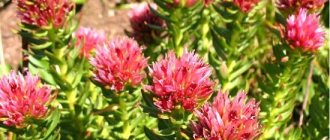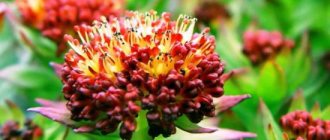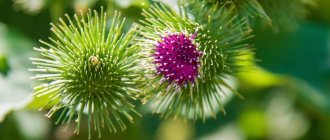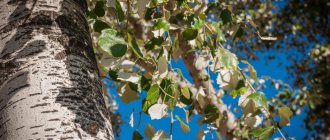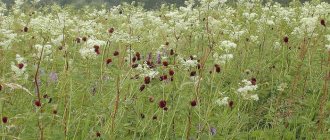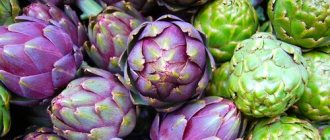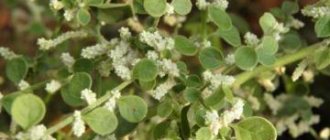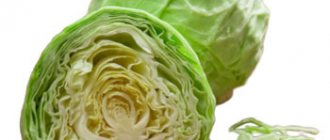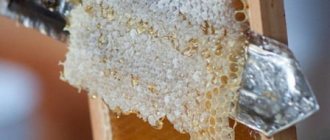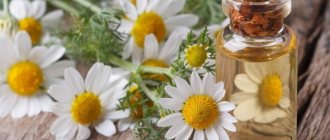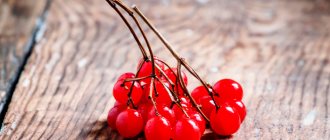Rhodiola is a genus of perennial plants from the Crassulaceae family. The genus branches into an average of 90 species, but Rhodiola rosea has become the most popular. The composition of the plant has attracted the attention of pharmacology, cosmetology, perfumery and even the sports industry. Rhodiola was nicknamed the “golden root”, included in the Red Book, and control over the cultivation and use of the component was strengthened.
What is hidden behind the unsightly Rhodiola flowers and how can the plant be of interest to the consumer?
General characteristics of the plant
Rhodiola rosea is a perennial herbaceous plant. Acceptable name is rose/golden root. The etymology of the alternative name is simple - the rhizome of the plant is painted the color of old gold, which gives off a specific pearlescent sheen.
Botanical description
Rhodiola is a succulent dioecious plant with a powerful horizontal rhizome and miniature oblong adventitious roots. Erect stems emerge from the dense rhizome. In total, up to 15 stems with a height of 10 to 40 centimeters can develop. Rhodiola with a single stem is extremely rare. The leaves are alternate, sessile, and acquire an elliptical shape of an elongated egg; less often, pointed leaves with a solid edge or a serrated upper part are found.
Content:
- General characteristics of the plant
- Features of the composition
- Rhodiola as an adaptogen
- Pharmacological action of the plant
- Application of the component in various industries
- Possible harm and contraindications for use
Inflorescences are formed from several yellow flowers. They are painted in a bright yellow shade. Later, greenish, erect fruits form from the flowers. Rhodiola blooms from June to July. Fruit ripening occurs in July-August. The plant reproduces in two ways: vegetative and seed.
Rhodiola is not particularly demanding on environmental conditions. The main thing is that the plant receives the necessary amount of moisture. Abundant flowing moisture is the key to high-quality growth and development of fruits. Rhodiola does well without a lot of heat or sunlight. This does not affect the quality, chemical composition and beneficial properties of the plant.
Territorial distribution
The plant prefers cold, temperate climates. The largest percentage of Rhodiola plantings are concentrated in North America, Ireland, Great Britain, the Alps, the Carpathians, the Pyrenees, Altai, the Urals, on the coast of the White/Barents Sea and in the mountainous regions of Siberia.
Brief historical background
Ancient Chinese emperors mounted massive expeditions to Altai and other mountainous regions to obtain golden root. In addition to high-ranking government officials, Rhodiola was the subject of interest for smugglers. They found plantings, plucked everything they could steal and smuggled goods across the border. Previously, Rhodiola root was considered the greatest rarity, and its cost was several times higher than the price of gold.
In Altai there is still a proverb: “Whoever finds the golden root will live up to 120 years in health and happiness.”
Collection and storage of raw materials
Medicines from the Rhodiola rosea plant can be purchased at the pharmacy. But many people grow it in their garden. In order for it to retain its medicinal properties, it must be collected and stored correctly.
Rhodiola leaves are harvested in early summer. They need to be dried in a well-ventilated area, spread out in a thin layer. Store in sealed containers in a dry place. They retain their properties throughout the year.
To avoid damaging the plant, carefully dig out some of the roots. They are cleared of soil and damaged areas and cleaned of the top layer. Then cut into 10 cm pieces and dried. You can do it in the oven, but the temperature should not be higher than 50˚C. Store such raw materials for no more than 2 years.
Features of the composition
About 140 biologically active components are concentrated in the underground part of the plant. Roots and rhizomes contain phenols and their derivatives. Phenols are the end of the side group of tyrosine, and therefore are part of the vast majority of protein molecules. The composition includes organic acids (succinic, citric, oxalic, malic), carbohydrates (fructose, glucose), aromatic compounds (cinnamic alcohol, rosin), essential oils (citral, phenylethyl alcohol, geraniol, cinnamaldehyde). The composition is also rich in flavonoids, tannins, steroids and beneficial nutrients.
Rhodiola, growing in different countries, may have different compositions and opposing properties.
The benefits of tea, decoction, infusion of Rhodiola rosea
Research by scientists has shown that pink radiola has a beneficial effect in any form (decoction, infusion, tea). However, to achieve maximum effect, you should use the medicine only freshly prepared.
In this case, it will have the following useful properties:
- Anti-inflammatory.
- Regenerating.
- Healing.
- Enveloping.
- Antibacterial.
- Protective.
- Immunostimulating.
Morphological and biochemical studies have shown that infusions, teas, and decoctions of golden root can become a medicine for the prevention of diseases of the respiratory system. That is why experts recommend giving the medicine to children starting from toddlerhood.
Rhodiola as an adaptogen
The first impression of the term “adaptogen” can be quite misleading. This is not a new technological development, but the name of a group of plants that have been known for their medicinal properties since ancient times. Adaptogens come to us from Ayurveda and traditional Chinese medicine. This group of plants has not lost its popularity and inexhaustible benefits for several centuries.
What are they and how do adaptogens work?
Adaptogens solve problems with hormonal imbalance, increased levels of emotional and physical stress. These are three battlefields in which the powers of ordinary plants play an extremely important role. Adaptogens affect the functioning of the sympathetic nervous system, thyroid gland and adrenal glands. As soon as the work of these organs and systems is aligned, the whole body is healed.
The uniqueness of the group of adaptogens is revealed by their name. After entering the body, they adapt to the individual characteristics of a person and bring the entire internal space into balance. They give energy to a tired person or calm to an overly excited person.
Regulation of the production of hormones and enzymes by adaptogens affects:
- cholesterol level;
- liver and heart;
- breathing process;
- immune system;
- brain cells;
- nervous system;
- age-related changes.
Functions of Rhodiola as an adaptogen
This is one of the few adaptogens that has been sufficiently researched and valued in the post-Soviet space. The plant is a natural antidepressant, the spectrum of action of which is much wider than that of pharmaceutical medications. Rhodiola not only normalizes cortisol levels, but helps normalize sleep and food intake, despite the stress experienced. After taking pharmaceutical medications, a person feels exhausted and tired, which makes it difficult to return to their usual routine. The mild effect of a natural adaptogen ensures a quick and painless transition from a state of stress to natural activity.
What else is useful for Rhodiola rosea:
- increases physical endurance;
- increases mental focus capabilities;
- fights early aging of the body;
- copes with excess fat deposits;
- protects against pathogenic radioactive exposure and toxic chemicals.
What is Golden Root, photo
Goldenseal or rose Rhodiola (Rhodiola rosea) is a herbaceous plant that grows in countries with temperate or cool climates. Its flowering occurs in mid-summer. The inflorescences are yellow, sometimes greenish.
From a medical point of view, the rhizome of the plant is mainly used for the treatment of pathological processes. But in addition to this, the inflorescence and leaves can be used. After the flowering period of this plant, its positive qualities begin to appear more actively.
Pharmacological action of the plant
In evidence-based medicine, alcohol extract and various extracts from Rhodiola rosea are used. The active components of the plant are used for:
- stimulation of the central nervous system;
- medications for asthenic and neurasthenic conditions;
- tablets for increased fatigue (also used for mentally healthy patients);
- medications for functional pathologies of the nervous system;
- rehabilitation manipulations.
It has been proven that Rhodiola protects red blood cells from the harmful effects of stress and increases the body's resistance to depression and fatigue. The plant stimulates the central nervous system, improves neuroprotective properties and prevents significant loss of stem cells.
The hydroalcoholic extract of the plant helps the body wean itself off drugs. The component “erases” the habit of drug use, and upon subsequent use it produces an ambiguous reaction - nausea, vomiting, a sharp increase in temperature, tremor, headache, and an unstable psychological state. Scientists claim that the extract helps quit smoking, treats opium addiction and has an anti-stress effect on the body during overeating.
What else is the herbal component useful for:
- reduces the overall level of anxiety;
- improves brain activity;
- prevents the development of a number of diseases (from colds to cancer);
- treats sexual disorders;
- increases endorphin levels.
Contraindications for golden root
This medicine can have a strong effect on the patient's body. It is not prescribed in the following cases:
- Children whose age does not reach 8 years.
- Nervous strain and severe feverish conditions.
- The use of the drug during all trimesters of pregnancy and during breastfeeding is strictly prohibited.
- Arterial hypertension in advanced forms.
Application of the component in various industries
Cooking
The product is used extremely rarely in the gastronomic industry. It is not profitable for large industrial companies to regulate the planting and use of a plant for which additional control has been established. Only the above-ground part of the plant can be used as a food product, but its taste and structure cannot be called a gastronomic breakthrough. More often the component is used as an adaptogen, medicinal or cosmetic component.
Medicine
The plant is included in preparations for:
- oxygen starvation;
- respiratory infections;
- diabetes mellitus;
- gout;
- fever;
- diseases of the teeth and oral cavity;
- jaundice;
- hypotension;
- problems of the skeletal system;
- neuroses, schizophrenia.
Cosmetics and perfume industry
Clinical medical studies on humans have confirmed the safety and benefits of Rhodiola. The component is especially effective on sensitive and aging skin. Rhodiola extracts are used in face, body and hair care products.
Creams based on Rhodiola stimulate skin renewal, slow down the aging process, increase the skin's ability to withstand aggressive external environments - ultraviolet radiation, pathogenic microorganisms, toxic chemical compounds.
Recommendation: the quick and effective effect of medicinal cosmetics based on Rhodiola will be noted by people with sensitive, irritated and damaged skin. For normal, dry and oily skin, it is best to choose cosmetics with a different range of actions.
After contact with the skin, the extract begins to act. First, metabolic processes are regulated, then energy metabolism in cells is stabilized. Oxidation of fats and carbohydrates occurs, due to which the skin tone is evened out and blackheads disappear. The regeneration process starts and gains momentum, and the barrier functions of the dermis increase. A few hours after application, the feeling of tightness and dryness disappears. After a few days, peeling goes away, after the course the skin’s water balance, elasticity, color, and protective functions are restored.
Sports industry
Preparations based on Rhodiola rosea tone/stimulate not only nervous but also muscle activity. They significantly increase your performance and will help you gain/lose a few kilograms, improve your results before a competition, or run a long-awaited marathon. Long-term use of the component really strengthens the muscle corset, making a person more resilient and strong.
When to use Rhodiola rosea for healthy people:
- when overworked;
- during the rehabilitation period (after infectious/somatic diseases) in order to quickly return to the natural rhythm of life;
- for periods of work that require increased mental activity;
- for maintaining and restoring muscles after/during prolonged intense physical activity;
- during the period of carbohydrate loading before competitions;
- for speedy recovery after training;
- to increase the capacity of the respiratory chain;
- to increase the body's resistance to infections;
- with overtraining.
Useful properties and uses of golden root tincture
The benefits of pink radiola were known in ancient times, but then the plant was used exclusively as a cure for colds, insomnia, and stomach. After conducting research, it was revealed that the plant has a wider spectrum of action, so it is used to eliminate many diseases, let’s consider the most basic of them:
- Due to its adaptogenic effect, Rhodiola is widely used to improve the functionality of the immune system.
- Golden root tones blood vessels, due to which they become more elastic, and supports/treats patients with hypotension.
- Due to its sedative properties, the plant is used as an antidepressant.
- Due to the ability of radiola to lower sugar levels, it is prescribed to patients with diabetes or people prone to it. This reduces the risk of atherosclerotic plaques that affect the functionality of the vascular system.
Consequently, thanks to this remedy it is possible to treat diseases and carry out their prevention, but it is recommended to coordinate treatment with golden root with a doctor, because in some cases its healing effect may not be enough.
How to deal with diseases and pests when growing Rhodiola in the garden?
The plant is resistant to both diseases common to many garden flora and pests. However, weevils (bergenia and sedum) can cause some trouble. In the first case, the insect appears on the site along with the root system of Rhodiola, which previously grew in natural conditions. The pest attacks the rhizome, which is the most valuable part and is used for medicinal purposes. Therefore, it is recommended to carry out a thorough inspection when purchasing seedlings, but if pest larvae were found after bringing them home, then you should soak such roots for 10 minutes in a saline solution or use potassium permanganate, then the soaking time will be 15 minutes.
The sedum weevil damages parts of plants located above the ground. The presence of a pest can be determined by the presence of small holes on the leaf blades of Rhodiola, and subsequent yellowing of the foliage. Weevil larvae also damage stems by gnawing holes in them. To combat it, it is recommended to shake off insects onto a material that is covered with an adhesive substance. These manipulations are carried out both in spring and with the arrival of autumn.
Possible side effects
If the dosage is observed, Rhodiola rosea preparations will not cause side effects. If the dose is exceeded or taken for a long time, the following may occur:
- excessive excitement, increased irritability;
- insomnia or constant drowsiness;
- unpleasant sensation in the heart area;
- headaches, pain;
- allergy;
- decreased performance;
- increased blood pressure;
- increase in blood pressure.
